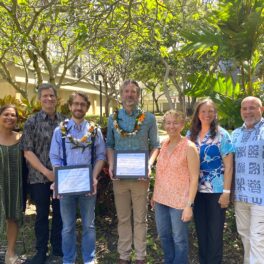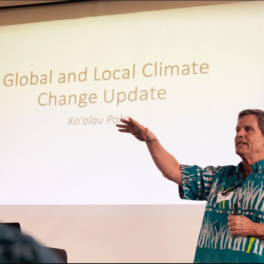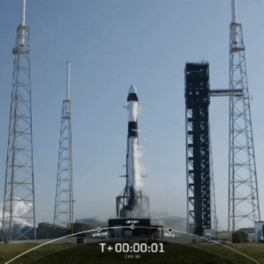Certain coral species thriving, offer glimmer of hope
 Narrissa Spies sets traps for coral spawning. Credit: Narrissa Spies.
Narrissa Spies sets traps for coral spawning. Credit: Narrissa Spies.
In a recent lecture at UH-Hilo, Narrissa Spies, a doctoral candidate with Bob Richmond, director of the Kewalo Marine Lab in the SOEST Pacific Biosciences Research Center, told those gathered, “Over the past 40 years, coral reefs have declined by 50 percent and that’s crazy. Between 1997 and 1998 there was a global bleaching event, an El Nino event, which led to a 70 percent die-off of the coral reef in Florida and the Caribbean.”
In the midst of the doom and gloom, Spies’ research into the molecular biology of coral in Hawaii is offering a glimmer of hope. She has been investigating how certain species of coral are thriving despite stress caused by rising ocean temperatures, pollutants and sediment runoff.
Unexpectedly, her study field is not in the azure waters of the Pacific but instead the polluted Honolulu Harbor.
“It’s a terrible place for any person or fish or anyone else to live, but believe it or not there are corals there that are thriving under this pressure,” Spies said. “And it kind of gives us a little bit of hope.”
As part of her research, she followed the effects on coral and marine life from a massive molasses spill in the harbor in 2013.
“Something as harmless as molasses was an ecological disaster because we could not clean it up,” Spies said. “There was no plan for how to deal with this water-soluble mess other than to wait and let it flush out.”
More than 200 gallons of molasses spilled, killing more than 26,000 fish and countless invertebrates including cucumbers, worms and especially corals. Old colonies of lace coral that were massive and decades-old were completely destroyed when the molasses caused the tissue on the coral to slough off.
There was no chance for that coral to recover, but Spies and her team found two coral colonies that were fine in the molasses water and thriving.
And that, she feels, is a game changer.
“While we didn’t expect to find any kind of life resembling a healthy coral reef ecosystem in this area of Honolulu Harbor, it’s among the most important because this is where selection has already occurred,” Spies said.
“It’s a place where you’re already getting the weaklings weeded and are left with these hardy different genotypes and species that have a better shot of handling the type of stress they’ll experience soon as the effects of climate change worsen.”
Read the full story on West Hawaii Today.



